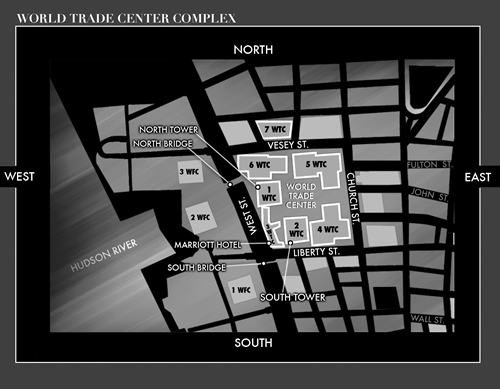9-11 Attack in New York: Difference between revisions
imported>Howard C. Berkowitz No edit summary |
imported>Howard C. Berkowitz |
||
| Line 41: | Line 41: | ||
A Field Communications Van did arrive, but the command posts stayed in the lobbies of the affected buildings. | A Field Communications Van did arrive, but the command posts stayed in the lobbies of the affected buildings. | ||
===New York Police Department=== | |||
===Port Authority Police=== | |||
The WTC is leased by the Port of New York Authority, an interstate organization that has its own police force. Its officers receive more firefighting and rescue training than do regular police officers. | |||
==Rescue operations== | ==Rescue operations== | ||
==Immediate response to the collapse== | ==Immediate response to the collapse== | ||
Revision as of 13:46, 3 August 2009
Not only was the 9-11 Attack impactful on the world, it had many special effects in New York City. Prior to it, the worst line-of-duty death toll in the Fire Department of New York was 12, in the Wonder Drug & Cosmetics fire on 17 October 1966.[1] Prior to it, the most massive high-rise incident was the 1993 World Trade Center bombing.
World Trade Center
To understand the operational context, it must be realized that the World Trade Center contains a number of buildings beyond those hit by the aircraft, WTC1 (North Tower) and WTC2 (South Tower), both 110-story structures. There are also a number of critical infrastructure functions under the entire complex.
Debris damaged other buildings in the complex, some, such as WTC7, to the point that they collapsed. Other buildings were damaged beyond economic repair.
Other building complexes nearby, such as the World Financial Center (WFC), were also affected.
First response
Command and control
There were serious problems of command and control both among the various emergency response agencies (Fire, Police, Transit Authority Police, etc.) and within individual agencies. The Incident Command System never functioned on an interagency basis, nor was a Joint Command Post supporting the site created under ICS standards.
In July 2001, Mayor Giuliani updated a directive titled "Direction and Control of Emergencies in the City of New York." Its purpose was to eliminate "potential conflict among responding agencies which may have areas of overlapping expertise and responsibility." The directive sought to accomplish this objective by designating, for different types of emergencies, an appropriate agency as "Incident Commander." This Incident Commander would be "responsible for the management of the City's response to the emergency," while the OEM was "designated the 'On Scene Interagency Coordinator.'"[2]
Nevertheless, the FDNY and NYPD each considered itself operationally autonomous. As of September 11, they were not prepared to comprehensively coordinate their efforts in responding to a major incident. The OEM had not overcome this problem.
Multiple police departments had jurisdiction, but had little to no interoperable communications with the FDNY. When NYPD helicopters saw the top of the building start to sag, an imminent warning of collapse, they were unable to radio this to the FDNY.
Office of Emergency Management
There was a citywide Office of Emergency Management, which had three basic functions.
- OEM's Watch Command was to monitor the city's key communications channels-including radio frequencies of FDNY dispatch and the NYPD-and other data.
- improve New York City's response to major incidents, including terrorist attacks, by planning and conducting exercises and drills that would involve multiple city agencies, particularly the NYPD and FDNY.
- managing the city's overall response to an incident. After OEM's Emergency Operations Center was activated, designated liaisons from relevant agencies, as well as the mayor and his or her senior staff, would respond there. In addition, an OEM field responder would be sent to the scene to ensure that the response was coordinated.27
The OEM's headquarters was located at 7 WTC. Some questioned locating it both so close to a previous terrorist target and on the 23rd floor of a building (difficult to access should elevators become inoperable). There was no backup site.
Fire Department of New York
In what proved to be a catastrophic decision, but was not inconsistent with existing doctrine for high-rise building fires, the Incident Command Post was set up in the lobby of the first building struck. Since most high-rise fires are contained to several floors, and there is normally a fire command room in the building, with access to its internal communications, sensors, and sprinklers, this has some merit for smaller fires. Once the decision was made, however, that the fire could not be extinguished, and the operation was one of rescue, it would have been wise to move the ICP to an outside facility. At the Pentagon, the ICP was always in an Arlington County Fire Department mobile command post.
A Field Communications Van did arrive, but the command posts stayed in the lobbies of the affected buildings.
New York Police Department
Port Authority Police
The WTC is leased by the Port of New York Authority, an interstate organization that has its own police force. Its officers receive more firefighting and rescue training than do regular police officers.
Rescue operations
Immediate response to the collapse
Recovery operations
Environmental effects
Lessons learned
References
- ↑ Terry Golway (2002), So Others Might Live: A History of New York's Bravest, the FDNY from 1700 to the Present, Basic Books, ISBN 0465027407, pp. 219-226
- ↑ National Commission on Terrorist Attacks Upon the United States, Chapter 9: Heroism and Horror, 9-11 Commission Report
